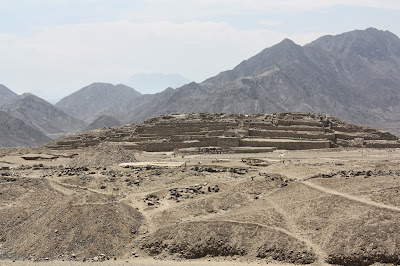 |
| Ollantaytambo |
There are still parts that look unfinished in Ollantaytambo, this could be because there was a remodel undergo when the Spanish invaded, possibly underway because of the Incan emperor Pachacuti. There still remains a ramp where the blocks are expected to have been dragged up from the nearby quarry. There are stones that do not have a "home, but this could also be to earthquakes, or the Spanish destroying certain parts of a building that cast the stones further from their original site.
An interesting aspect about Ollantaytambo is the storehouse that is directly across the valley that is visibly higher altitude, the higher altitude was to limit or prevent food decay. Like most agricultural terraces of the time there is extensive drainage and irrigation system throughout the terraces, this still holds today and prevents large amounts of erosion or flooding despite the modern changes in the town below.
 |
| View from Atop Ollantaytambo - View of Storehouse |
While there is not much credible information that I have found about the actual inhabitants or interesting information on the habits of Ollantaytambo, there is a good deal of information or speculation about the construction and architecture. There is the double jammed doorway with such precise stonework that is mostly used in prestigious Inca buildings, this could indicate that Inca nobility or important people of the realm lived here at one point like an imperial estate, this site has been likened to Machu Picchu because of this possibility. There is also a half built Temple to Inti, that was thought to be been in process when the spaniards arrived. This leads archaeologists to believe that this area was used for ceremonies or even just a center for administrative purposes. In other words everybody seems to agree that this area was important for a variety of reason, and the evidence to support this is the beautiful stonework. Stones that fit together so closely, without the use of mortar and that have lasted for years and will continue to do so.
 |
| Solid Stone some weighing up to 50 tons |

